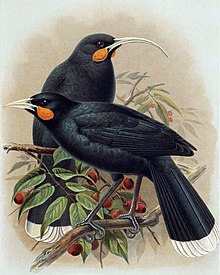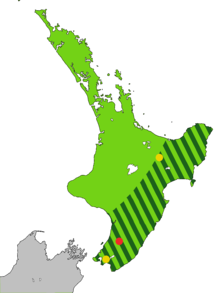
Back طيور الهويا Arabic হুইয়া Bengali/Bangla Huïa Catalan Heteralocha acutirostris CEB Laločník ostrozobý Czech Huia German Heteralocha acutirostris Spanish Heteralocha acutirostris Basque نوکتیزک Persian Huia Finnish
| Huia Temporal range: Holocene
| |
|---|---|

| |
| A pair of huia (male in front of female) Painting by J. G. Keulemans from W. L. Buller's A History of the Birds of New Zealand (1888) | |
| Scientific classification | |
| Domain: | Eukaryota |
| Kingdom: | Animalia |
| Phylum: | Chordata |
| Class: | Aves |
| Order: | Passeriformes |
| Family: | Callaeidae |
| Genus: | †Heteralocha Cabanis, 1851 |
| Species: | †H. acutirostris
|
| Binomial name | |
| †Heteralocha acutirostris (Gould, 1837)
| |

| |
| Light green: original range Dark green stripes: 1840 range Red: site of 1907 last confirmed sighting Yellow: sites of later unconfirmed sightings | |
| Synonyms | |
|
Neomorpha acutirostris (female) | |
The huia (/ˈhuːjə, -iːə/ HOO-yə, -ee-ə;[2] Māori: [ˈhʉiˌa]; Heteralocha acutirostris) is an extinct species of New Zealand wattlebird, endemic to the North Island of New Zealand. The last confirmed sighting of a huia was in 1907, although there was another credible sighting in 1924.[3]
It was already a rare bird before the arrival of Europeans, confined to the Ruahine, Tararua, Rimutaka and Kaimanawa mountain ranges in the south-east of the North Island.[4][5] It was remarkable for its pronounced sexual dimorphism in bill shape; the female's beak was long, thin and arched downward, while the male's was short and stout, like that of a crow. Males were 45 cm (18 in) long, while females were larger at 48 cm (19 in). The sexes were otherwise similar, with orange wattles and deep metallic, bluish-black plumage with a greenish iridescence on the upper surface, especially about the head. The tail feathers were unique among New Zealand birds in having a broad white band across the tips.
The birds lived in forests at both montane and lowland elevations – they are thought to have moved seasonally, living at higher elevations in summer and descending to lower elevations in winter. Huia were omnivorous and ate adult insects, grubs and spiders, as well as the fruits of a small number of native plants. Males and females used their beaks to feed in different ways: the male used his bill to chisel away at rotting wood, while the female's longer, more flexible bill was able to probe deeper areas. Even though the huia is frequently mentioned in biology and ornithology textbooks because of this striking dimorphism, not much is known about its biology; it was little studied before going extinct.
The huia is one of New Zealand's best-known extinct birds because of its bill shape and beauty, as well as its special place in Māori culture and oral tradition. The bird was regarded by Māori as tapu (sacred), and the wearing of its skin or feathers was reserved for people of high status.
- ^ BirdLife International (2017) [amended version of 2016 assessment]. "Heteralocha acutirostris". IUCN Red List of Threatened Species. 2017: e.T22708091A119257859. Retrieved 28 December 2019.
- ^ "huia". The Chambers Dictionary (9th ed.). Chambers. 2003. ISBN 0-550-10105-5.
- ^ Wood, Caroline (18 January 2017). "Hunting the last huia". Forest and Bird. Retrieved 4 November 2021.
- ^ Cite error: The named reference
FGBNZwas invoked but never defined (see the help page). - ^ Cite error: The named reference
Tennyson, Martinsonwas invoked but never defined (see the help page).
